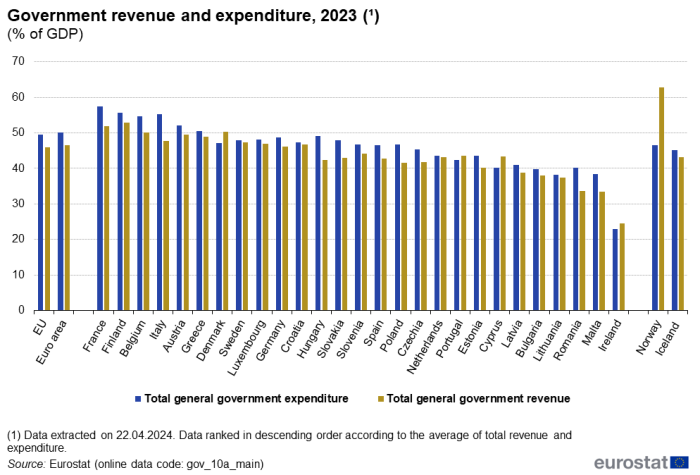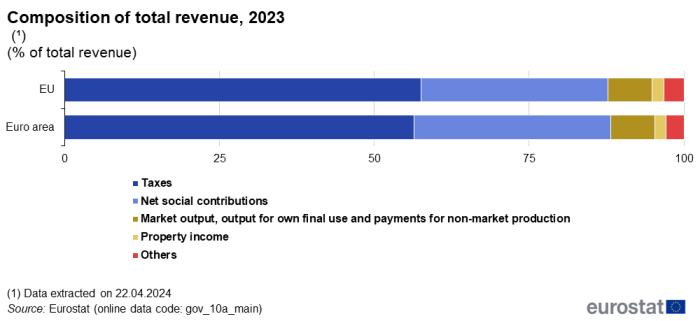Government finance statistics
Data extracted on 22 April 2024.
Planned article update: 22 October 2024.
Highlights
In the euro area the government deficit to GDP ratio declined from -3.7 % in 2022 to -3.6 % in 2023, and in the EU it increased from -3.4 % to -3.5 %.
In the euro area the government debt to GDP ratio decreased from 90.8 % at the end of 2022 to 88.6 % at the end of 2023, and in the EU from 83.4 % to 81.7 %.
At the end of 2023, the government debt to GDP ratio ranged from 19.6 % in Estonia to 161.9 % in Greece.
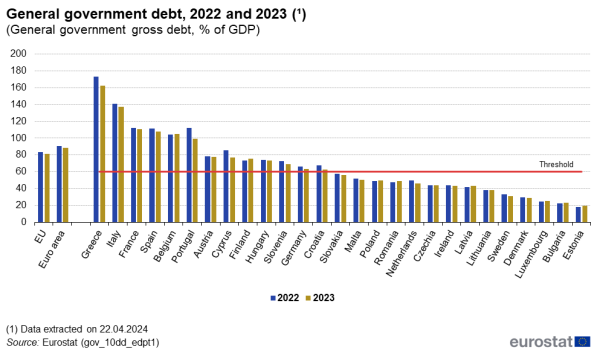
(general government gross debt, % of GDP)
Source: Eurostat (gov_10dd_edpt1)
This article examines how key government finance statistics have developed in the European Union (EU) and the euro area (EA). Specifically, it considers general government deficits, gross debt, total revenue and total expenditure, as well as taxes and social contributions, which are the main sources of government revenue.
Full article
Introduction
Government finance statistics contain crucial indicators for determining the health of the economies of the EU Member States. Under the terms of the EU's Stability and Growth Pact (SGP), Member States pledged to keep their deficits and debt below certain limits: a Member State's government deficit may not exceed 3 % of its gross domestic product (GDP), while its debt may not exceed 60 % of GDP. If a Member State does not respect these limits, the so-called excessive deficit procedure (EDP) is triggered. This entails several steps — including the possibility of sanctions — to encourage the Member State concerned to take appropriate measures to rectify the situation. The same deficit and debt limits are also criteria for economic and monetary union (EMU) and hence for joining the euro. Furthermore, the latest revision of the integrated economic and employment guidelines (revised as part of the Europe 2020 strategy for smart, sustainable and inclusive growth) includes a guideline to ensure the quality and the sustainability of public finances.
In the euro area (EA) the government deficit to GDP ratio declined from -3.7 % in 2022 to -3.6 % in 2023, whereas in the EU EU it increased from -3.4 % in 2022 to -3.5 % in 2023. In the euro area the government debt to GDP ratio decreased from 90.8 % at the end of 2022 to 88.6 % at the end of 2023, and in the EU from 83.4 % to 81.7 %.
In the euro area the government debt-to-GDP ratio decreased from 90.8 % at the end of 2022 to 88.6 % at the end of 2023, and in the EU from 83.4 % to 81.7 %.
General government surplus/deficit
The EU's government deficit-to-GDP ratio increased from -3.4 % in 2022 to -3.5 % in 2023, while this ratio decreased in the euro area from -3.7 % to -3.6 %.
In 2021 and 2022, deficits decreased after the the highest values in the time series (-7.0 % for the euro area and -6.7 % for the EU) had been recorded in 2020. The economic down-turn caused by the COVID-19 pandemic, as evidenced by a drop in nominal GDP between 2019 and 2020, as well as the expenditure measures to contain the economic and social impact of the COVID-19 pandemic had a strong impact on the deficit and debt ratios in 2020. In 2022 and 2023, the high energy prices and the measures undertaken by EU governments to alleviate their impact, had a strong influence on the government balance, so that for the EU and euro area, deficits remained at a relatively elevated level.
In 2023, all Member States, except Cyprus and Denmark (both reported a surplus of +3.1 %), Ireland (+1.7 %) and Portugal (+1.2 %), reported a deficit. The highest deficits were recorded in Italy (-7.4 %), Hungary (-6.7 %) and Romania (-6.6 %). In total, eleven Member States had deficits higher than 3 % of GDP: Italy, Hungary, Romania, France, Poland, Malta, Slovakia, Belgium, Czechia, Spain and Estonia.
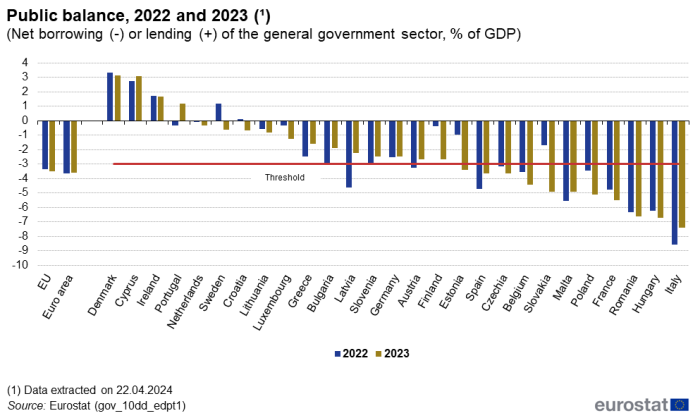
(Net borrowing (-) or lending (+) of the general government sector, % of GDP)
Source: Eurostat (gov_10dd_edpt1)
The general government balance (in relation to GDP) decreased for 16 EU Member States in 2023 compared with 2022, while an increase was recorded for ten EU Member States. For Germany, the deficit to GDP ratio remained unchanged between 2022 and 2023 at -2.5 %. The largest increases were noted in Latvia (+2.4 percentage points (pp)), Portugal (+1.5 pp), Italy (+1.2 pp) and Spain (+1.1 pp), while the largest decreases were noted in Slovakia (-3.2 pp), Estonia (-2.4 pp) and Finland (-2.3 pp).
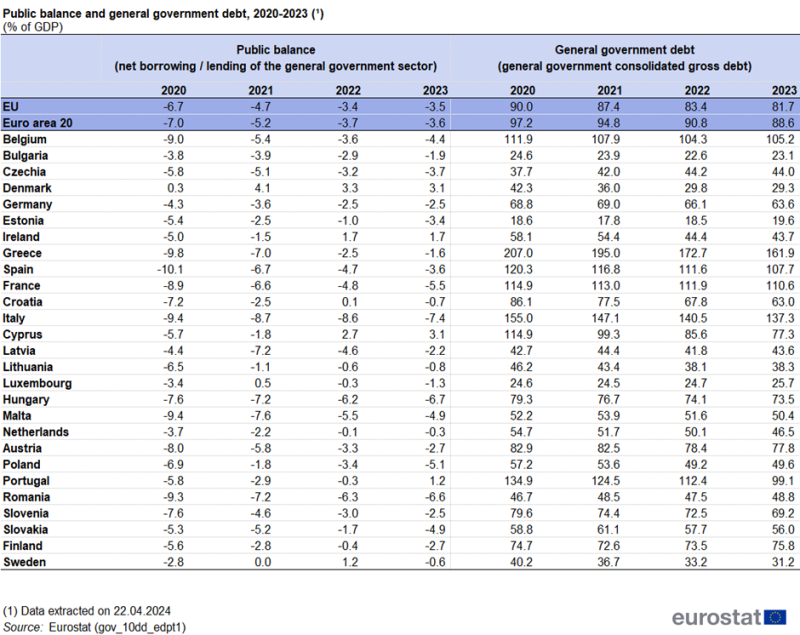
(% of GDP)
Source: Eurostat (gov_10dd_edpt1)
General government gross debt
In the EU, the government debt-to-GDP ratio decreased from 83.4 % at the end of 2022 to 81.7 % at the end of 2023, while in the euro area it decreased from 90.8 % to 88.6 % (see Figure 2).
At the end of 2023, the lowest ratios of government debt to GDP were recorded in Estonia (19.6 %), Bulgaria (23.1 %), Luxembourg (25.7 %), Denmark (29.3 %), Sweden (31.2 %) and Lithuania (38.3 %). Thirteen Member States had government debt ratios higher than 60 % of GDP, with the highest registered in Greece (161.9 %), Italy (137.3 %), France (110.6 %), Spain (107.7 %) and Belgium (105.2 %).
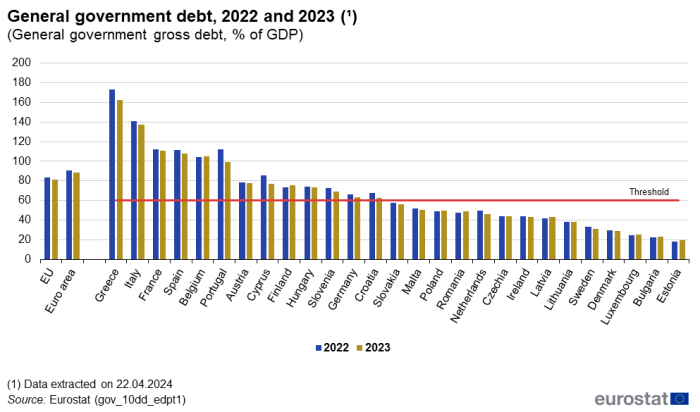
(general government gross debt, % of GDP)
Source: Eurostat (gov_10dd_edpt1)
Compared with 2022, nine Member States registered an increase in their debt to GDP ratio at the end of 2023 and 18 Member States a decrease at the end of 2023. The largest increases in the ratio were recorded in Finland (+2.3 pp), Latvia (+1.8 pp), Romania (+1.3 pp) and Estonia (+1.1 pp), while the largest decreases were observed in Portugal (-13.3 pp), Greece (-10.8 pp), Cyprus (-8.3 pp), Croatia (-4.8 pp) and Spain (-4.0 pp).
At the level of the EU and euro area the decreases in the debt to GDP ratio in 2023 are due to the increases in GDP outweighing the increases in government debt in absolute terms. Debt increases when governments need to borrow in order to finance their deficits. Another important reason for an increase in government debt is the need for governments to finance the acquisition of financial assets. Further information is available in Eurostat's note on the stock-flow adjustment, describing the relationship between the deficit and the change in debt.
Government revenue and expenditure
The importance of the general government sector in the economy may be measured in terms of total general government revenue and expenditure as a percentage of GDP. In 2023, government expenditure in the euro area was equivalent to 50.0 % of GDP and government revenue to 46.4 % of GDP. The figures for the EU were 49.4 % and 45.9 %, respectively. The government expenditure and revenue ratios decreased in the EU and the euro area compared with 2022 — see Figure 3.
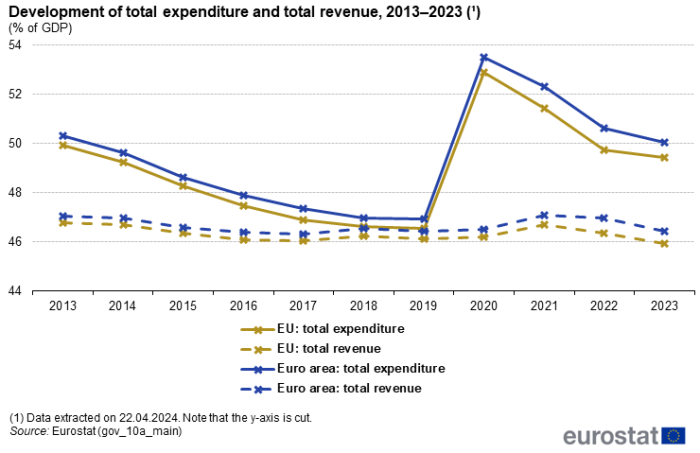
(% of GDP)
Source: Eurostat (gov_10a_main)
Despite the decreases in total expenditure as a percentage of GDP in both the EU and euro area in 2023, the levels remain above the long-term trends as a result of the expenditure measures put in place to mitigate the impact of high energy prices as well as the continuation of some measures to combat economic and social impact of the COVID-19 containment measures that started in 2020 and continued in 2021 and 2022. In the period between 2013 and 2019, total expenditure as a percentage of GDP followed a decreasing trend in the EU and in the euro area. In 2020, the ratio increased +6.3 pp in the EU and +6.6 pp in the euro area compared with the previous year. In 2023, the reduction of the general government total expenditure to GDP ratios by -0.3 pp in the EU and -0.6 pp the euro area marks a less pronounced decrease as compared with the previous year two years.
In absolute terms, during the period from 2013 to 2018 in the EU and the euro area, general government total expenditure grew at a slower pace than general government total revenue, thereby leading to decreasing deficits. This trend stopped in 2019, when expenditure grew slightly faster than revenue in both the EU and the euro area, resulting in an increase in the deficit. In 2020, total revenue decreased by -3.8 % in the EU and -4.2 % in the euro area, while total expenditure increased by 9.2 % in the EU and 9.1 % in the euro area. In 2020, the decrease in government total revenue was both due to automatic stabiliser effects of tax revenue (meaning that in an economic downturn, tax revenue decreases even without active policy measures) as well as due to active tax cutting measures in order to mitigate the economic downturn caused by the COVID-19 pandemic. In 2021, government revenue increased by 9.9 % at the level of the EU and 9.7 % at the level of the euro area, while expenditure increased by 5.7 % at the level of the EU and 5.9 % at the level of the euro area, reducing the gap between the two. This reduction of the gap continued in 2022, when government revenue increased by 7.9 % at the level of the EU and 8.0 % in the euro area, while expenditure increased by 5.1 % at the level of the EU and 4.7 % at the level of the euro area. In 2023 general government total revenue increased by 5.6 % at the level of the EU and 5.3 % in the euro area, while expenditure increased by 6.0 % at the level of the EU and 5.2 % in the euro area.
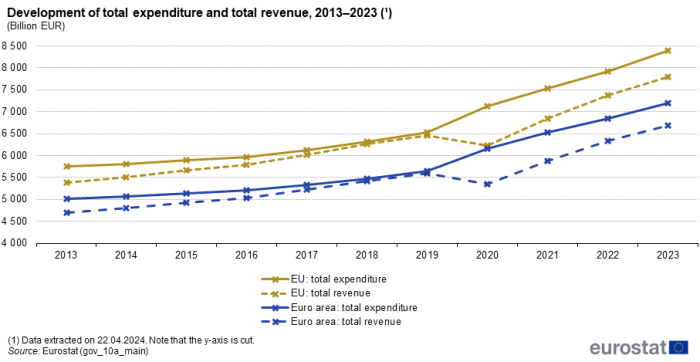
(billion EUR)
Source: Eurostat (gov_10a_main)
While EU general government expenditure increased overall by €2 639 billion between 2013 and 2023, there was a €2 406 billion increase in EU general government total revenue in the same period. Between 2022 and 2023, EU government total expenditure increased by €471 billion, while government revenue increased by €415 billion. In the euro area, general government expenditure increased by €2 173 billion between 2013 to 2023, while total revenue increased by €1 983 billion. Between 2022 and 2023, euro area government total expenditure increased by €357 billion, while government revenue increased by €335 billion (see Figure 4).
The level of general government expenditure and revenue varies considerably between the EU Member States (see Figure 5). In 2023, the EU Member States with the highest levels of combined government expenditure and revenue as a proportion of GDP (in excess of 100 %) were France, Finland, Belgium, Italy and Austria; Norway also recorded a ratio in excess of 100 %. In 2023, six EU Member States (Ireland, Malta, Romania, Lithuania, Bulgaria and Latvia) reported relatively low combined ratios (less than 80 % of GDP).
Components of general government total revenue
Across the EU, the main components of total general government revenue are taxes and net social contributions (see Figure 6). In 2023, taxes made up 57.5 % of total revenue in the EU and 56.4 % in the euro area, while net social contributions amounted to 30.2 % of total revenue in the EU and 31.7 % in the euro area. Market output, output for own final use and payments for non-market production ('sales/fees' and own account capital formation) made up 7.1 % of total revenue in the EU and 7.2 % in the euro area. Property income (mainly interest, dividends and rent) made up 1.9 % of total revenue in the EU and 1.7 % of total revenue in the euro area.
Looking at each reporting country, the relative importance of the different revenue categories varied widely. Taxes made up less than 50 % of general government total revenue in Slovakia (46.7 %), Czechia (46.9 %), Romania (47.2 %) and Slovenia (47.6 %) in 2023. By contrast, taxes made up 87.1 % of general government total revenue in Denmark, 80.4 % in Sweden, 75.6 % in Ireland as well as 76.8 % in Iceland.
Net social contributions had the highest shares in total revenue in 2023 in Czechia (38.2 %), Germany (37.3 %), Slovenia (36.5 %) and Slovakia (35.7 %). The lowest shares of social contributions in total revenue were recorded in Denmark (1.4 %) and Sweden (6.8 %) as well as in Iceland (6.9 %).
The highest share of property income was observed for Norway (27.3 %), mainly due to revenue from oil and gas extraction (see Figure 7).
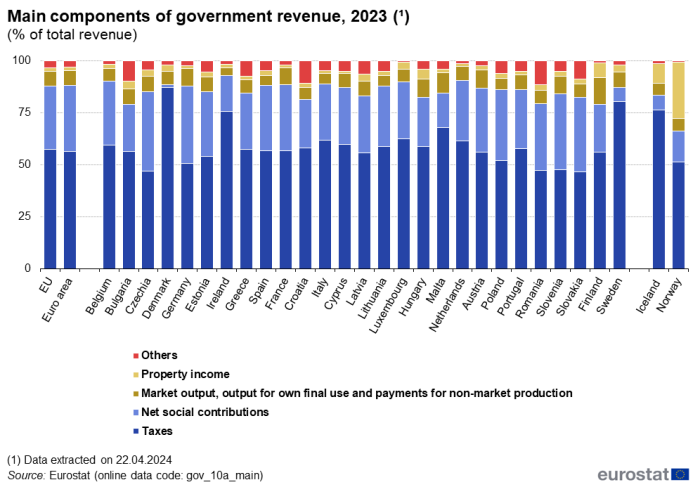
(% of total revenue)
Source: Eurostat (gov_10a_main)
Components of general government total expenditure
The largest proportion of EU government expenditure in 2023 concerned the redistribution of income in the form of social transfers in cash or in kind (see Figures 8 and 9).
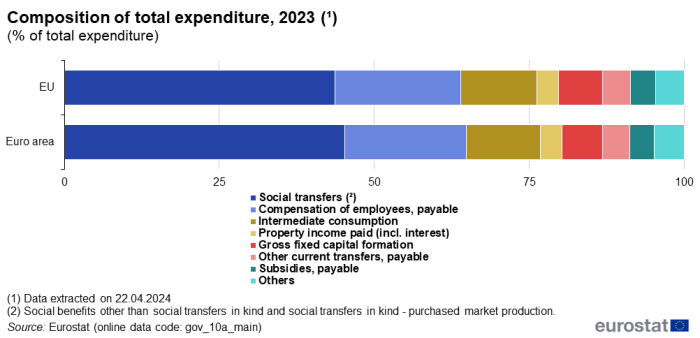
(% of total expenditure)
Source: Eurostat (gov_10a_main)
Social transfers (social benefits and social transfers in kind — purchased market production) made up 43.6 % of total expenditure in the EU and 45.2 % in the euro area. Compensation of employees (wages and salaries as well as employers' social contributions) accounted for 20.3 % of government total expenditure in the EU and 19.6 % in the euro area. Intermediate consumption (the purchase of goods and services needed for production) made up 12.4 % of total expenditure in the EU and 11.9 % of total expenditure in the euro area. Property income paid — of which by far the largest part is made up of interest payments — accounted for 3.5 % of government expenditure in both the EU and in the euro area. Gross fixed capital formation (mainly investments in non-financial assets) accounted for 7.1 % of total expenditure in the EU and 6.5 % in the euro area. Subsidies made up 4.0 % of total expenditure in the EU and 3.9 % of total expenditure in the euro area. The share of subsidies in total expenditure increased significantly in 2020 and stayed at a high level throughout 2021 due to labour market support measures as well as other measures to mitigate the economic impact of the COVID-19 pandemic containment measures. The COVID-19 related subsidies largely decreased in 2022 and were no longer impacting expenditure in 2023 but were partly replaced by subsidies on products (e.g. electricity and petrol) and production (e.g. public transportation) to mitigate the impact of high energy prices.
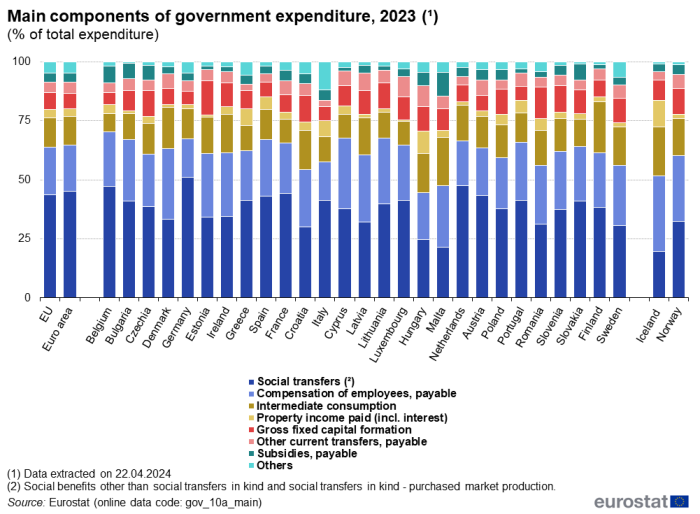
(% of total expenditure)
Source: Eurostat (gov_10a_main)
The highest shares of social transfers in total expenditure were observed in Germany (51.0 %), the Netherlands (47.4 %) and Belgium (47.3 %), while the lowest shares were observed in Malta (21.3 %) and Hungary (24.8 %) as well as in Iceland (19.8 %). In 2023, the share of subsidies in total expenditure was highest in Malta (10.0 %), followed by Belgium (7.0 %) and Slovakia (6.9 %), Bulgaria (6.5 %) and Czechia (6.2 %). In 2023, property income paid (including interest) reached a share of more than 5 % of total expenditure for Hungary (9.6 %) and Italy and Greece (both 6.8 %) as well as Iceland (11.1 %).
Taxes and social contributions
The main types of government revenue are taxes on production and imports, current taxes on income and wealth, etc., and net social contributions. For the EU, taxes on production and imports amounted to an equivalent of 12.9 % of GDP in 2023, current taxes on income, wealth, etc. to 13.2 % of GDP, and net social contributions to 13.9 % of GDP.
Relative to GDP, the revenue from taxes on production and imports remained nearly stable as a ratio to GDP over the period 2013–2019 in the EU (see Figure 10). In 2020, the ratio decreased by -0.3 pp only to increase by 0.4 pp in 2021. In 2022, taxes on production and imports relative to the GDP decreased by -0.2 pp, while in 2023, taxes on production and imports relative to the GDP decreased by -0.4 pp.
Current taxes on income and wealth increased steadily from 12.7 % of GDP in 2013 to 13.4 % of GDP in 2022 only to decrease to 13.2 % in 2023. Current taxes on income and wealth are dominated by personal income taxes, which remain relatively stable in comparison with corporate income taxes, which tend to fluctuate more from year to year.
Net social contributions remained comparatively stable as a ratio to GDP while following a slightly decreasing trend - ranging between 14.4 % in 2013 and 2014 and 14.1 % of GDP in 2019. In 2020, net social contributions increased to 14.5 % of GDP. One of the reasons for the 2020 increase in net social contributions revenue was that many of the labour market support schemes and other social measures in the Member States ensured a continued coverage of contributions so that the impact of the COVID-19 pandemic was less pronounced than for taxes on production and imports. In 2023 at the level of the EU, net social contributions revenue stood at 13.9 % of GDP, i.e. lower than the ratio before the COVID-19 pandemic.
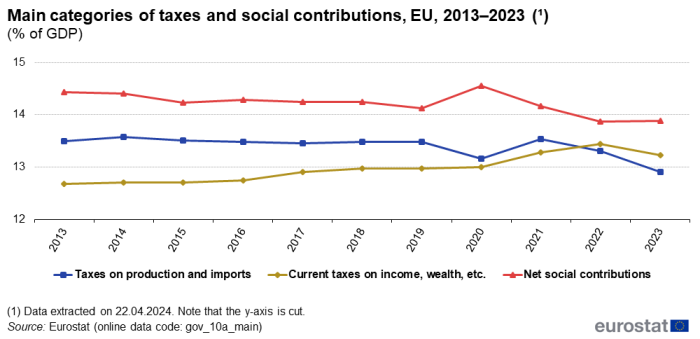
(% of GDP)
Source: Eurostat (gov_10a_main)
There was considerable variation in the structure of tax revenue across the EU Member States in 2023 (see Figure 11). As may be expected, those Member States that reported relatively high levels of expenditure tended to be those that also raised more taxes and social contributions (as a proportion of GDP) for general government. For example, in 2023, the highest revenue to GDP ratio from the main categories of taxes and social contributions was 45.1 % of GDP recorded in France, followed by 44.6 % recorded in Belgium, 44.3 % of GDP in Denmark, 42.9 % in Austria, 42.4 % of GDP in Italy and 42.0 % in Luxembourg. The proportion of GDP accounted for by such revenue was below 30 % in Ireland (22.7 %), Romania (26.7 %), Malta (28.1 %) and Bulgaria (29.7 %),
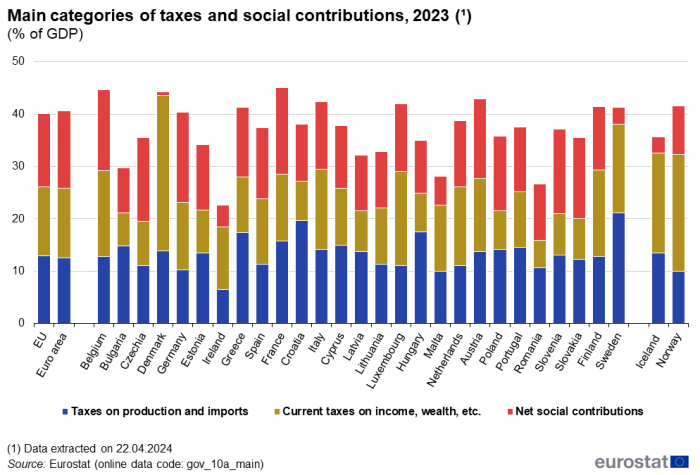
(% of GDP)
Source: Eurostat (gov_10a_main)
Source data for tables and graphs
Data sources
Under the terms of the excessive deficit procedure, EU Member States are required to provide the European Commission with their government deficit and debt statistics before 1 April and 1 October of each year. In addition, Eurostat collects more detailed data on government finance statistics within the framework of the transmission programme which results in the submission of national accounts data. The main aggregates for general government are provided to Eurostat twice a year, whereas statistics on the functions of government (COFOG) should be transmitted within one year after the end of the reference period and detailed tax and social contribution receipts within nine months after the end of the reference period. Quarterly non-financial and financial accounts as well as quarterly general government gross debt are provided four times a year.
The data presented in this article correspond to some of the main indicators of the general government sector, which are compiled on a national accounts (ESA 2010) basis.
The difference between total revenue and total expenditure — including capital expenditure (in particular, gross fixed capital formation) — equals net lending/net borrowing of general government, which is also one balancing item of the government non-financial accounts.
Delineation of general government
The general government sector consists of institutional units which are non-market producers whose output is intended for individual and collective consumption, and are financed by compulsory payments made by units belonging to other sectors, and institutional units principally engaged in the redistribution of national income and wealth (ESA 2010 §2.111). The general government sector is subdivided into four subsectors: central government, state government (where applicable), local government, and social security funds (where applicable).
Definition of main indicators
The public balance is defined as general government net borrowing/net lending reported for the excessive deficit procedure and is expressed in relation to GDP. According to the protocol on the excessive deficit procedure, government debt is the gross liabilities in currency and deposits, debt securities, and loans outstanding at the end of the year of the general government sector measured at nominal (face) value and consolidated.
The main revenue of general government consists of taxes, social contributions, sales and property income. It is defined in ESA 2010 by reference to a list of categories: market output, output for own final use, payments for non-market output, taxes on production and imports, other subsidies on production, property income, current taxes on income, wealth, etc., net social contributions, other current transfers and capital transfers.
The main expenditure items consist of the compensation of (government) employees, social benefits (social benefits and social transfers in kind for market production purchased by general government), interest on the public debt, subsidies, and gross fixed capital formation. Total general government expenditure is defined in ESA 2010 by reference to a list of categories: intermediate consumption, gross capital formation, compensation of employees, other taxes on production, subsidies, property income, current taxes on income, wealth, etc., social benefits other than social transfers in kind, social transfers in kind - purchased market production, other current transfers, adjustments for the change in pension entitlements, capital transfers, and transactions in non-produced assets.
General government data reported for main aggregates of general government in the ESA 2010 framework must be consolidated for certain national accounts transactions, meaning that specific transactions between institutional units within the general government sector — property income, other current transfers and capital transfers — are eliminated or cancelled out. For these transactions, subsector data should be consolidated within each subsector but not between subsectors. Thus, data at the sector level should equal the sum of the subsector data, except for the items covering property income, other current transfers and capital transfers, which are consolidated. For these latter items, and consequently total revenue and total expenditure, the sum of the subsectors should exceed the value of the sector.
Taxes and social contributions correspond to revenues which are levied (in cash or in kind) by central, state and local governments, and social security funds. These levies (generally referred to as taxes) are organised into three main areas, covered by the following headings:
- taxes on income and wealth, etc. including all compulsory, unrequited payments levied periodically by general government on the income and wealth of enterprises and households;
- taxes on production and imports, including all compulsory, unrequited payments levied by general government with respect to the production and importation of goods and services, the employment of labour, the ownership or use of land, buildings or other assets used in production;
- net social contributions, including all employers' and households' actual social contributions, imputed social contributions that represent the counterpart to social benefits paid directly by employers, as well as two additional imputed items (households' social contribution supplements and social insurance scheme services charges).
Context
The global financial and economic crisis of 2007-2008 resulted in serious challenges being posed to many European governments. The main concerns were linked to the ability of national administrations to be able to service their debt repayments, take the necessary action to ensure that their public spending was brought under control, while at the same time trying to promote economic growth.
The disciplines of the Stability and Growth Pact (SGP) are intended to keep economic developments in the EU, and the euro area countries in particular, broadly synchronised. Furthermore, the SGP is intended to prevent EU Member States from taking policy measures which would unduly benefit their own economies at the expense of others. There are two key principles to the SGP: namely, that the deficit (planned or actual) must not exceed 3 % of GDP and that the debt-to-GDP ratio should not be more than (or should be falling towards) 60 %. The SGP was substantially reinforced in 2011, as was EU economic governance in general.
Each year, EU Member States provide the European Commission with detailed information on their economic policies and the state of their public finances. Euro area countries provide this information in the context of the stability programmes, while other Member States do so in the form of convergence programmes. The European Commission assesses whether the policies are in line with agreed economic, social and environmental objectives and may choose to issue a warning if it believes a deficit is becoming abnormally high. This action can lead to the Council finding the existence of an excessive deficit, which requires a deadline to be set for its correction.
Direct access to
- Government expenditure by function — online publication
- Government finance statistics (EDP and ESA2010) (gov_gfs10)
- Government contingent liabilities and potential obligations (gov_cl)
- Government deficit and debt (ESMS metadata file — gov_10dd_esms)
- Government revenue, expenditure and main aggregates (ESMS metadata file — gov_10a_main_esms)
- Main national accounts tax aggregates (ESMS metadata file — gov_10a_taxag)
- General government expenditure by function (COFOG) (ESMS metadata file — gov_10a_exp_esms)
- Quarterly financial accounts for general government (ESMS metadata file — gov_10q_ggfa_esms)
- Quarterly government debt (ESMS metadata file — gov_10q_ggdebt_esms)
- Quarterly non-financial accounts for general government (ESMS metadata file — gov_10q_ggnfa_esms)
- Manual on government deficit and debt — implementation of ESA 2010 — 2022 edition
- Manual on sources and methods for the compilation of COFOG statistics - Classification of the Functions of Government (COFOG) - 2019 edition
- Manual on quarterly financial accounts for general government — 2017 edition
- Manual on quarterly non-financial accounts for general government — 2011 edition
